Healing - Experience - Nakaheji Old road (No.1)
Healing - Experience -
Okumotori,
Kogumotori Old road (No.2)
Healing -
Experience - From Hongu to
Shingu (No.3)
Healing -
Experience - Kumano
Kaido Old road (No.4)
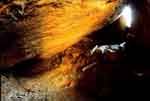 Tai Nai Kuguri describes both a place and a
process. Literally it means 'Passing Through the Womb'.
In this picture we can see one such 'Tai Nai Kuguri'
located in Nakaheji-cho. Tai Nai Kuguri are usually found
in caves and large holes in trees; one enters as one
person only to come out transformed, healed, or renewed.
They symbolize the nature of the womb which protects,
nurtures, and gives birth to new life.
Tai Nai Kuguri describes both a place and a
process. Literally it means 'Passing Through the Womb'.
In this picture we can see one such 'Tai Nai Kuguri'
located in Nakaheji-cho. Tai Nai Kuguri are usually found
in caves and large holes in trees; one enters as one
person only to come out transformed, healed, or renewed.
They symbolize the nature of the womb which protects,
nurtures, and gives birth to new life.
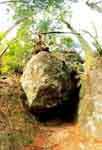 Tai Nai Kuguri in
general are a symbol of Kumano as a 'Land of Rebirth'
where anyone, regardless of their sex, status, stage, or
condition in this life, could find their way to some
degree of physical, emotional, mental, or spiritual
renewal. The ill, the defeated, the pilgrim, the lost
soul, all could find in Kumano the protection and
nurturing that would bring them to the next stage in
their life and some degree of transformation. There is a
legend about a woman who gave birth at this Tai Nai
Kuguri in Nakaheji-cho and left her baby to be taken care
of by a lone wolf, which is one of the symbols of the
guardian spirit of Kumano. This story symbolizes the
protective nurturing power of the Tai Nai Kuguri and
Kumano as a whole.
Tai Nai Kuguri in
general are a symbol of Kumano as a 'Land of Rebirth'
where anyone, regardless of their sex, status, stage, or
condition in this life, could find their way to some
degree of physical, emotional, mental, or spiritual
renewal. The ill, the defeated, the pilgrim, the lost
soul, all could find in Kumano the protection and
nurturing that would bring them to the next stage in
their life and some degree of transformation. There is a
legend about a woman who gave birth at this Tai Nai
Kuguri in Nakaheji-cho and left her baby to be taken care
of by a lone wolf, which is one of the symbols of the
guardian spirit of Kumano. This story symbolizes the
protective nurturing power of the Tai Nai Kuguri and
Kumano as a whole.
to the top
 On the road to Kumano there are many stone
mileage markers and shrines. On the way from Kyoto to
Kumano pilgrims would stop and pray at each shrine and
purify the body and mind. This shrine and marker is
particularly special in that it represents a kind of
unseen border of a sanctuary or sacred place which after
being passed one has entered into the protective womb of
Kumano. There is a nuance of leaving the mundane or outer
world and entering into the protective womb of the Kumano
entity. Of the many shrines along the way this is one of
five which have major symbolic significance in the Kumano
region. At this particular Oji shrine pilgrims would
usually enter the river for misogi (purification by water
ritual). Emperor Toba of the Heian era held Waka poem
readings here with his entourage on the way to Kumano.
On the road to Kumano there are many stone
mileage markers and shrines. On the way from Kyoto to
Kumano pilgrims would stop and pray at each shrine and
purify the body and mind. This shrine and marker is
particularly special in that it represents a kind of
unseen border of a sanctuary or sacred place which after
being passed one has entered into the protective womb of
Kumano. There is a nuance of leaving the mundane or outer
world and entering into the protective womb of the Kumano
entity. Of the many shrines along the way this is one of
five which have major symbolic significance in the Kumano
region. At this particular Oji shrine pilgrims would
usually enter the river for misogi (purification by water
ritual). Emperor Toba of the Heian era held Waka poem
readings here with his entourage on the way to Kumano.  This shrine is the third shrine which is passed
after entering into Nakaheji-cho on the way from Tanabe.
The shrine has been deemed a Prefectural Cultural
Treasure as the oldest shrine on the Kumano old road.
After passing this shrine, along the way some graves can
be found of several pilgrims who died on their way to
Kumano.
This shrine is the third shrine which is passed
after entering into Nakaheji-cho on the way from Tanabe.
The shrine has been deemed a Prefectural Cultural
Treasure as the oldest shrine on the Kumano old road.
After passing this shrine, along the way some graves can
be found of several pilgrims who died on their way to
Kumano.  On the way to Kumano along the Nakaheji Route
just before Chikatsuyu Oji can be found a statue of a
child riding a cow and a horse together on the way to
Kumano. This statue is said to be made in the likeness of
the Emperor Kazan on his tragic trip to Kumano.
On the way to Kumano along the Nakaheji Route
just before Chikatsuyu Oji can be found a statue of a
child riding a cow and a horse together on the way to
Kumano. This statue is said to be made in the likeness of
the Emperor Kazan on his tragic trip to Kumano. 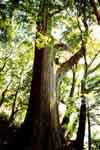 Passing Chikatsuyu Oji and Hisohara Oji brings
you to Tsugizakura Oji where you can see a huge cedar
with all its branches reaching towards the Nachi Grand
Shrine, the destination of the Kumano Pilgrimage. This
tree is known as 'IppoSugi' ('One Direction Cedar').
Passing Chikatsuyu Oji and Hisohara Oji brings
you to Tsugizakura Oji where you can see a huge cedar
with all its branches reaching towards the Nachi Grand
Shrine, the destination of the Kumano Pilgrimage. This
tree is known as 'IppoSugi' ('One Direction Cedar'). 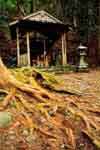 This is the thirteenth shrine after Takijiri
Oji. Here the Kumano Kodo Old Road enters Hongu-cho. This
is one of five other important shrines on this road. This
is the first shrine after the most difficult stretch
facing pilgrims on the Nakaheji Route. Pilgrims would
stop here to rest and perform purification rituals in the
valley nearby. After Yukawa Oji, pilgrims would pass over
'Mikoshi Summit', the last summit in Nakaheji before
entering into the divine territory of Kumano Hongu Grand
Shrine, the first destination of the pilgrimage.
This is the thirteenth shrine after Takijiri
Oji. Here the Kumano Kodo Old Road enters Hongu-cho. This
is one of five other important shrines on this road. This
is the first shrine after the most difficult stretch
facing pilgrims on the Nakaheji Route. Pilgrims would
stop here to rest and perform purification rituals in the
valley nearby. After Yukawa Oji, pilgrims would pass over
'Mikoshi Summit', the last summit in Nakaheji before
entering into the divine territory of Kumano Hongu Grand
Shrine, the first destination of the pilgrimage.  There are
five of the Ninety-Nine Kumano Gongen Shrines which are
considered to be of greater importance. One of these is
Hosshinmon Oji Shrine". It is considered as the
entranceway to the Hongu Grand Shrine, the first of the
Three Grand Shrines along the Kumano pilgrimage route.
'Hosshin' means to make a decision to surrender to the
spiritual path, in this case of Buddhism.
There are
five of the Ninety-Nine Kumano Gongen Shrines which are
considered to be of greater importance. One of these is
Hosshinmon Oji Shrine". It is considered as the
entranceway to the Hongu Grand Shrine, the first of the
Three Grand Shrines along the Kumano pilgrimage route.
'Hosshin' means to make a decision to surrender to the
spiritual path, in this case of Buddhism. 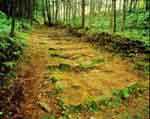 Here you can see an ancient stone path on the
way to Kumano which meanders through Cypress and Cedar
groves. In ancient times, the pilgrims, after a long hard
journey, dragged themselves along this road as they
anticipated arriving at the Kumano Hongu Grand Shrine
which was not far off. This path is now often enjoyed by
hikers and those interested in the history of Kumano.
Here you can see an ancient stone path on the
way to Kumano which meanders through Cypress and Cedar
groves. In ancient times, the pilgrims, after a long hard
journey, dragged themselves along this road as they
anticipated arriving at the Kumano Hongu Grand Shrine
which was not far off. This path is now often enjoyed by
hikers and those interested in the history of Kumano.  After a long journey, it was here that pilgrims
would fall instinctively to their knees in prayer upon
catching their first glimpse of the Hongu Grand Shrine.
There is a famous story about a well-known female poet of
the Heian Era who, after arriving at this point in her
long pilgrimage to Kumano, began her menstrual period.
This caused her great disappointment and deep despair for
she believed that this made her unclean and not fit
enough to be able to visit the Kumano Hongu Grand Shrine.
She then wrote a poem describing her sorrow and
despondency. On that same night she received a poem from
the Kumano Gongen (Kumano Entity) saying that all beings
were equal in the eyes of God, that God is within all
beings and all things regardless of status or position,
and that whether one is an emperor, clothed in rags,
menstruating, or a piece of garbage on the side of the
road, all are divine in essence, so there was no reason
why she should feel dirty and that she should not
hesitate to enter the divine territory of the Grand
Shrine. She then happily visited the shrine grateful that
the boundless god of Kumano was so unconditionally
accepting.
After a long journey, it was here that pilgrims
would fall instinctively to their knees in prayer upon
catching their first glimpse of the Hongu Grand Shrine.
There is a famous story about a well-known female poet of
the Heian Era who, after arriving at this point in her
long pilgrimage to Kumano, began her menstrual period.
This caused her great disappointment and deep despair for
she believed that this made her unclean and not fit
enough to be able to visit the Kumano Hongu Grand Shrine.
She then wrote a poem describing her sorrow and
despondency. On that same night she received a poem from
the Kumano Gongen (Kumano Entity) saying that all beings
were equal in the eyes of God, that God is within all
beings and all things regardless of status or position,
and that whether one is an emperor, clothed in rags,
menstruating, or a piece of garbage on the side of the
road, all are divine in essence, so there was no reason
why she should feel dirty and that she should not
hesitate to enter the divine territory of the Grand
Shrine. She then happily visited the shrine grateful that
the boundless god of Kumano was so unconditionally
accepting. | Go to Next Page | Back to Experience-Healing Home | Go to Main Menu |